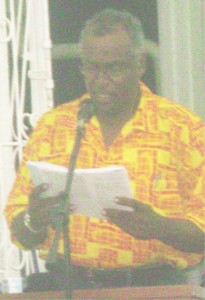Even as West Indian Literature continues to evolve, it seems almost imperative to remember the efforts of those pioneering authors who metaphorically ‘blazed the trail’. It was in this context that the work of Guyanese author Edgar Mittelholzer was celebrated on Tuesday evening at Castellani House.

The occasion was a specially arranged programme as part of the 28th Conference on West Indian Literature which concluded yesterday at the International Conference Centre. Tuesday evening was billed as “One hundred years of Edgar Mittelholzer: A Quiet Revolutionary”, as critics paid tribute to someone who was described repeatedly as a “pioneering” Guyanese literary and artistic figure. A special exhibition of his works and various critics was put together by the University of Guyana Library with assistance from the National Library. And Castellani House unveiled various collections which portrayed Guyana landscapes and embodied some of the themes that Mittelholzer demonstrated in his work.
But the question for many would be who really is Edgar Mittelholzer and what books did he write? Quite frankly a golden opportunity was missed on Tuesday evening to learn more about a man who has significantly impacted literature in Guyana and the Caribbean. Truth be told, not too many persons seemed interested in learning about Mittelholzer, a theory supported by the disappointing turnout at Castellani House. The absence of young people among the decent, but hardly spectacular gathering spoke volumes.

This year marks the centennial celebration of Mittelholzer’s birth. Guyanese by birth, he committed suicide in 1965, while a resident in England. Arguably his most popular work is My Bones and My Flute, a remarkable novel which stands out for its eeriness and its exploration of Guyana’s landscape.
Part of this was captured when Konya Addo read an extract from this novel in a presentation aided by the flute playing of Emile Trotz, a member of the Guyana Police Force Band.
However, the focus of Tuesday’s presentation was on another of Mittelholzer’s novels Corentyne Thunder, which was published in 1941, and which was described as a pioneering literary text.
The novel describes the experiences of peasant life in the colony.
It was introduced by Michael Khan whose reading of an extract was excellently done and well received. He too benefitted from the aid of musical instruments played by the Heredity Tassa Group which helped to create the necessary mood and the excitement.

Ameena Gafoor, Editor of the Arts Journal, delivered an extensive presentation in which she underscored the significance of Mittleholzer and his work to Guyana’s literary heritage and to the West Indies on the whole. She pointed out that he was a prolific writer since he was able to write 23 novels within 24 years.
She said that until Mittelholzer “intervened with Corentyne Thunder in 1941, the intellectual infrastructure of Guiana comprised largely of Travel writings”. This indicates that most of the work would have been done from the perspective of a third party capturing their journeys into the exoticism of the country or the region. She said that Mittelholzer’s work represented “the seminal work of imaginative prose writing in the colony by a native.”
She quoted from Michael Gilkes who had noted: “Although the attempt in the novel to assert a positive Caribbean way of life-a Caribbean identity and culture-began with earlier writers like Claude McKay, C.L.R. James and Alfred Mendes in the 1930s, it was Edgar Mittelholzer (with Corentyne Thunder, 1941) who first raised the question of the role of heredity itself: the phenomenon of racial admixture and cultural disorientation which is beneath the Caribbean’s writer’s deep psychological need to define racial and cultural identity in an attempt to heal a division of conscious”, which was a peculiarly Caribbean theme.
According to Gafoor, Mittelholzer was one of the earliest feminist writers in the region. She pointed to the portrayal of the character Kattree in Corentyne Thunder. According to her, this character represented “the first peculiarly post-modern image of an independent woman, in a society hard pressed to eke out a livelihood in the wake of indentureship”
Juanita Cox, a lecturer at the University of London, delivered the feature address titled “Corentyne Thunder: A Quiet Revolution”. She pointed out that Mittelholzer fought against stereotypical images of West Indian natives that were presented by the British and Americans and stated that he had an issue accepting the European ideologies as truth.
She also gave insight to how widely read Mittelholzer was by discussing in detail the author’s use of intertextuality in his work. Intertexuality refers to the influence of one text on another work.
Cox pointed out that in Corentyne Thunder, the author drew from writers such as Moliere, Stapledon, Conrad, Shakespeare and even musicians such as Beethoven. She stated that he was able to use these symbols in a unique way through which he was able to emphasise his aversion to the European stereotypes of the West Indian native. He was also not afraid to address the controversial topics such as sex and race relations,
As a fictive writer, Mittelholzer stood out the audience was told. And even as the West Indian literature continues to evolve, there is not doubt that much is owed to the foundation established by writers such as Mittelholzer.







